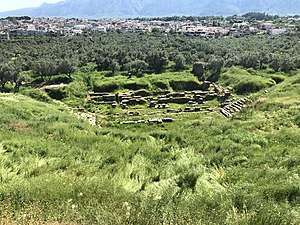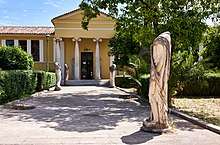Sparta, Laconia
Sparta (Greek: Σπάρτη, Spárti, [ˈsparti]) is a town and municipality in Laconia, Greece. It lies at the site of ancient Sparta. The municipality was merged with six nearby municipalities in 2011, for a total population (as of 2011) of 35,259, of whom 17,408 lived in the city.
Sparta Σπάρτη | |
|---|---|
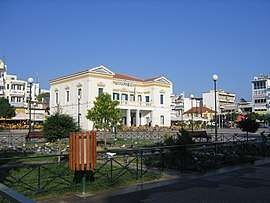 The center of the town with the town hall | |
 Flag  Seal | |
 Sparta Location within the region  | |
| Coordinates: 37°04′26″N 22°25′46″E | |
| Country | Greece |
| Administrative region | Peloponnese |
| Regional unit | Laconia |
| Government | |
| • Mayor | Evangelos Valiotis (as of 2014) |
| Area | |
| • Municipality | 1,181.8 km2 (456.3 sq mi) |
| • Municipal unit | 84.5 km2 (32.6 sq mi) |
| Lowest elevation | 200 m (700 ft) |
| Population (2011)[1] | |
| • Municipality | 35,259 |
| • Municipality density | 30/km2 (77/sq mi) |
| • Municipal unit | 19,854 |
| • Municipal unit density | 230/km2 (610/sq mi) |
| Community | |
| • Population | 17,408 (2011) |
| Time zone | UTC+2 (EET) |
| • Summer (DST) | UTC+3 (EEST) |
| Postal code | 231 00 |
| Area code(s) | 27310 |
| Vehicle registration | ΑΚ |
| Website | www |
History
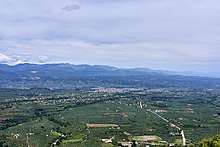
Beginning in the 13th century, the political and cultural center of Laconia shifted to Mystras, some 4 km to the west. The settlement at ancient Sparta, named Lacedaemonia, continued to exist, although greatly depopulated, until modern times as a town of a few thousand people who lived among the ruins, in the shadow of Mystras.[2] The Palaiologos family (the last Byzantine Greek imperial dynasty) also lived in Mystras. The Despotate of the Morea was captured by the Ottomans under Mehmed II in 1460.
In 1834, after the Greek War of Independence, King Otto of Greece decreed the town should be expanded into a city. Modern day Sparta, capital of the prefecture of Lakonia, lies on the eastern foothills of Mount Taygetos in the Evrotas River valley. The city has been built upon the site of ancient Sparta, whose Acropolis lies north of the modern city.[3] To the southwest stands Mt. Taygetos. To the east of the city stands the Parnonas mountain range, which is forested predominantly with Greek fir trees and other pines.
Modern Sparta's origins date back to October 20, 1834, when King Otto issued a decree on the construction of the new city. Bavarian city planners, headed by Fr. Stauffert, designed a city of 100,000 inhabitants based on the neo-classical architectural model.
Today Sparta maintains its good design, boasting large squares and wide streets lined with trees, while many of the older buildings remain in excellent condition. The city of Sparta is the economic, administrative and cultural center of Lakonia. A key factor in the advancement of the city's development is the operation of two departments of the University of Peloponnese and a department of the Technological Educational Institute.
The centrally located main square is dominated by the most imposing neo-classical building in Sparta, the City Hall. Built in 1909, City Hall bears the signature of the Greek architect, G. Katsaros.[4] During the monarchy (which was abolished by referendum in 1973), the title of Duke of Sparta was used for the Greek crown prince, the διάδοχος (diádokhos).
Municipality
.jpg)
The municipality of Sparta was formed at the 2011 local government reform by the merger of the following seven former municipalities, that became municipal units:[5]
The municipality has an area of 1,181.780 km2, the municipal unit 84.453 km2.[6] The municipal unit consists of the local communities Sparta, Afisi, Amykles, Kalyvia Sochas and Kladas.[5]
Politics
Sparta is the most conservative city in Greece. It has never had a left-wing mayor and it was one of the few cities that voted in 1974 to retain the monarchy. Laconia was the region with the highest proportion of "yes" votes (which was supported by the conservative party) in the 2015 bailout referendum.
Since 2019, the mayor of Sparta is Petros Doukas.[7]
Demographics
| Year | Town | Municipal unit | Municipality |
|---|---|---|---|
| 1961 | 10,412 | — | — |
| 1981 | 12,975 | — | — |
| 1991 | 13,011 | 16,322 | — |
| 2001 | 14,817 | 19,567 | — |
| 2011 | 17,408 | 19,854 | 35,259 |
Climate
The city of Sparta enjoys a sunny and warm Mediterranean climate (Köppen Csa). Winters are mild and cool, while summers tend to be particularly hot. January mean maximum temperatures are around 14 °C (57 °F) while July and August mean maximum temperatures are around 36 °C (97 °F) in the city proper and around 35 °C (95 °F) at the airport.[8] Sparta is notorious for its scorching summer heat; during July 2012 the city registered an average maximum temperature of 38.3 °C (100.9 °F), making it Greece's highest monthly average maximum temperature to date.[9]
| Climate data for Sparta, Laconia Regional Unit station (N.O.A, 2009–2018) | |||||||||||||
|---|---|---|---|---|---|---|---|---|---|---|---|---|---|
| Month | Jan | Feb | Mar | Apr | May | Jun | Jul | Aug | Sep | Oct | Nov | Dec | Year |
| Average high °C (°F) | 14.2 (57.6) |
15.6 (60.1) |
18.4 (65.1) |
23.2 (73.8) |
27.9 (82.2) |
32.5 (90.5) |
35.8 (96.4) |
35.8 (96.4) |
31.1 (88.0) |
24.7 (76.5) |
19.9 (67.8) |
15.8 (60.4) |
24.6 (76.2) |
| Daily mean °C (°F) | 8.9 (48.0) |
10.0 (50.0) |
12.2 (54.0) |
15.7 (60.3) |
20.2 (68.4) |
24.6 (76.3) |
27.6 (81.7) |
27.7 (81.9) |
23.7 (74.7) |
18.2 (64.8) |
13.8 (56.8) |
9.9 (49.8) |
17.7 (63.9) |
| Average low °C (°F) | 3.5 (38.3) |
4.3 (39.7) |
5.9 (42.6) |
8.1 (46.6) |
12.5 (54.5) |
16.7 (62.1) |
19.4 (66.9) |
19.5 (67.1) |
16.3 (61.3) |
11.7 (53.1) |
7.6 (45.7) |
4.0 (39.2) |
10.8 (51.4) |
| Average rainfall mm (inches) | 125.0 (4.92) |
105.4 (4.15) |
62.1 (2.44) |
29.1 (1.15) |
29.2 (1.15) |
37.1 (1.46) |
14.4 (0.57) |
15.2 (0.60) |
59.5 (2.34) |
65.1 (2.56) |
69.3 (2.73) |
80.3 (3.16) |
691.7 (27.23) |
| Source: Meteoclub.gr[10] | |||||||||||||
| Climate data for Sparta Airport (HNMS ,1974–2004) | |||||||||||||
|---|---|---|---|---|---|---|---|---|---|---|---|---|---|
| Month | Jan | Feb | Mar | Apr | May | Jun | Jul | Aug | Sep | Oct | Nov | Dec | Year |
| Average high °C (°F) | 14.4 (57.9) |
15.1 (59.2) |
17.7 (63.9) |
21.3 (70.3) |
27.0 (80.6) |
32.2 (90.0) |
34.8 (94.6) |
34.3 (93.7) |
30.5 (86.9) |
25.7 (78.3) |
19.4 (66.9) |
15.2 (59.4) |
24.0 (75.1) |
| Daily mean °C (°F) | 9.6 (49.3) |
10.2 (50.4) |
12.4 (54.3) |
15.8 (60.4) |
21.2 (70.2) |
26.2 (79.2) |
28.5 (83.3) |
27.8 (82.0) |
24.2 (75.6) |
19.6 (67.3) |
14.2 (57.6) |
10.8 (51.4) |
18.4 (65.1) |
| Average low °C (°F) | 3.5 (38.3) |
3.8 (38.8) |
5.5 (41.9) |
7.6 (45.7) |
11.8 (53.2) |
15.9 (60.6) |
18.7 (65.7) |
18.0 (64.4) |
15.3 (59.5) |
12.3 (54.1) |
8.2 (46.8) |
5.1 (41.2) |
10.5 (50.9) |
| Average rainfall mm (inches) | 90.7 (3.57) |
84.6 (3.33) |
73.3 (2.89) |
66.0 (2.60) |
47.4 (1.87) |
14.6 (0.57) |
18.8 (0.74) |
26.4 (1.04) |
30.8 (1.21) |
54.6 (2.15) |
90.0 (3.54) |
107.9 (4.25) |
705.1 (27.76) |
| Source: Meteoclub.gr[10] | |||||||||||||
Tourism
Main sites
In the center of the city is the Archaeological Museum. Built by architect G. Katsaros,
in 1874–76 to house the collection of local archaeological finds by Panagiotis Stamatakis, it was the first Greek museum in a provincial city.
The city's cathedral is at the southwest end.
The ruins of ancient Sparta lie north of the city. Entering by the South Gate of the Acropolis, known as Lakedaemonia, there is the Rotunda, the Theatre and the Temple of Athena Chalkioikos to the West. Exiting the Acropolis by the North Gate there are the remains of the earliest ancient walls, the Heroon and the Altar of Lycourgos, whereas to the East there is the Sanctuary of Artemis Orthia. To the North is the Monastic Church of Osios Nikonas (10th century).
The "Tomb of Leonidas", or Leonidaion (37.0767°N 22.4254°E), is a limestone structure of the late 5th century BC, likely a temple, but named for Leonidas I in the 19th century, being the only ancient monument indicated within the limits of the newly-planned town in 1834.[11]
Museums
- Archaeological Museum of Sparta
- The Museum of the Olive and Greek Olive Oil in the South West end highlights the culture of the olive and the technology of olive production, 129 Othonos–Amalias Street
- Archaeological Museum of Mystras - Founded by Gabriel Lilianthal in the late 19th century
- The Manousakeio Museum of urban and folk life
- Koumantareios Art Gallery of Sparta
- Angakis Art Gallery
Sports
The Spartathlon has taken place every September since 1983. It is an ultramarathon starting in Athens and finishing in Sparta at the statue of Leonidas, with many international participants.
The local football club is Sparta F.C.
People
- Nikiforos Vrettakos, writer
Twin towns - sister cities
Sparta is twinned with:[12]
.svg.png)
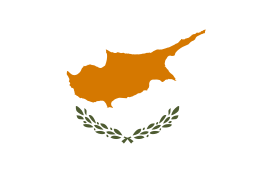







References
- "Απογραφή Πληθυσμού - Κατοικιών 2011. ΜΟΝΙΜΟΣ Πληθυσμός" (in Greek). Hellenic Statistical Authority.
- Encyclopædia Britannica Eleventh Edition
- "Αρχαία Σπάρτη". Αρχαιολογία Online (in Greek). Retrieved 2019-07-17.
- "Modern day Sparta". Retrieved 2014-09-06.
- Kallikratis law Greece Ministry of Interior (in Greek)
- "Population & housing census 2001 (incl. area and average elevation)" (PDF) (in Greek). National Statistical Service of Greece.
- "Δήμαρχος".
- "Meteoclub.gr". Retrieved 2014-09-05.
- "N.O.A July 2012 bulletin" (PDF). Retrieved 2013-01-20.
- Σπάρτη : H υπερδύναμη της καλοκαιρινής ζέστης στην Ελλάδα (in Greek). Meteoclub. Retrieved 7 June 2016.
- Sofia Voutsaki, Paul Cartledge, Ancient Monuments and Modern Identities: A Critical History of Archaeology in 19th and 20th Century Greece (2017), p. 50f.
- "Αδελφοποιημένες Πόλεις". sparti.gov.gr (in Greek). Sparta. Retrieved 2020-01-09.
External links
| Wikimedia Commons has media related to Sparti. |
- Laconia.org
- Official website Sparta municipality (in Greek)
